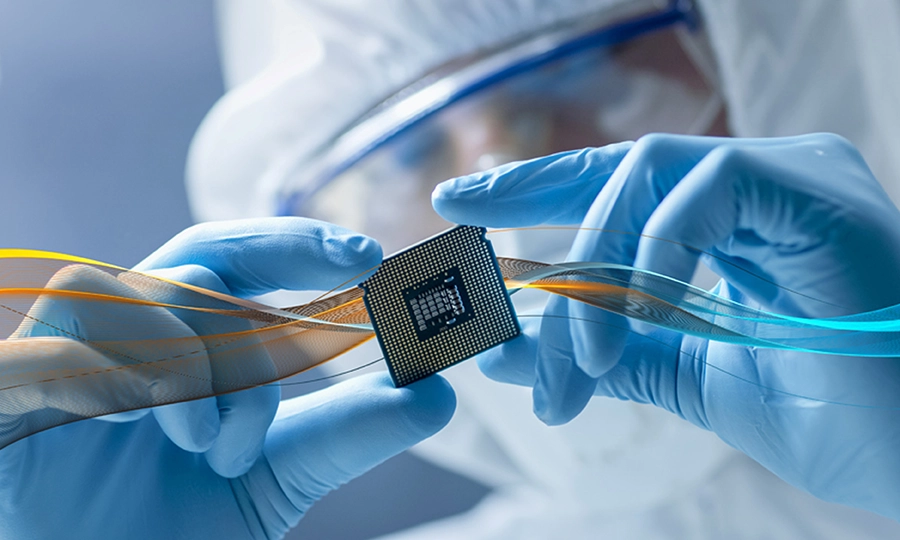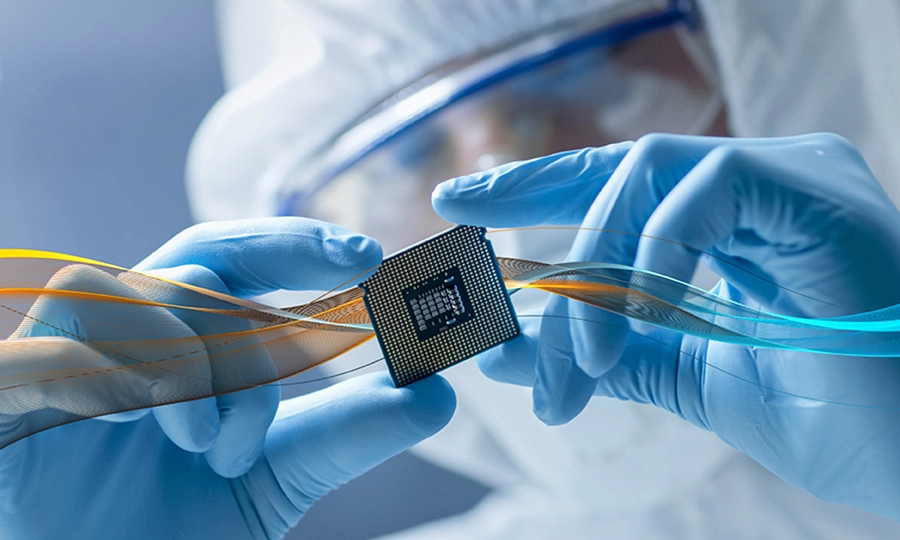

Marc Fuentes, North America Business Development
In 2020 and 2021, an unprecedented global chip shortage brought automotive production to its knees. Chip dealers in the US saw their inventory plunge to just 25 days’ supply, exposing a vulnerability that went far beyond economics. The crisis showed just how reliant North America had become on foreign semiconductor supply chains, creating not just business risks but national security concerns.
The 2022 CHIPS and Science Act’s $52 billion investment sought to address these concerns, with an unprecedented commitment to onshoring semiconductor capacity. By 2032, the US aims to supply approximately 30% of the world’s leading-edge chips, up from effectively 0% in 2020. But throwing money at the problem isn’t enough.
For manufacturers of high-end chips, a resilient semiconductor supply chain means more than new fabs—it demands a fundamental shift in how these facilities operate.
That shift starts with automation.
In this article
- The CHIPS Act allocated $52 billion toward revitalizing North American semiconductor manufacturing, with 13 companies receiving $30 billion in grants for 23 projects across 14 states.
- Modern semiconductor fabs are deploying collaborative robots, vision systems, and real-time analytics to achieve the precision and efficiency needed for competitive production.
- Digital oversight systems using IoT sensors and AI-powered analytics enable end-to-end supply chain visibility, tracking materials “all the way to the hole in the ground.”
- Automation enhances cybersecurity by enabling defense-in-depth networking, hardware encryption, and zero-trust architectures.
- Industries from automotive to aerospace are already benefiting from increased domestic chip production and transparent supply chains.
The automation imperative in modern chip manufacturing
Building a modern semiconductor fab is like constructing a cathedral of precision. Silicon wafers pass through hundreds of exacting steps—deposition, etching, lithography, testing—where even microscopic contamination can ruin entire batches. This complexity makes automation not just beneficial but essential.
As highlighted in reporting by the Association for Advancing Automation (A3), “Common to all these [fab expansion] initiatives is the need for automation to accelerate production. Whether it is wafer handling, wafer inspection, chemical and material handling, assembly and packaging, or metrology, modern semiconductor manufacturing provides a variety of applications for robotics, vision systems, and motion control products.”
The numbers tell the story. Major players are making massive commitments: Intel received an $8.5 billion grant for four new fabs, while Taiwan Semiconductor Manufacturing Company (TSMC) and Samsung are building facilities in Arizona and Texas. Collectively, these projects represent over $450 billion USD in announced private spending. Every one of these facilities will rely heavily on automation to achieve competitive yields and throughput.
At IBM’s Bromont facility in Quebec—North America’s largest chip-packaging factory—collaborative robots perform tasks requiring extreme precision, including component placement, optical alignment, and quality inspection. These are an entirely different category of robot from the large assembly-line robots familiar from automotive lines in the ‘90s and early ‘00s: they’re sophisticated systems that work alongside human operators, combining machine precision with human problem-solving capabilities.
From data silos to digital transparency
Automation in semiconductor manufacturing is just as much about data as robots. “Smart factory” practices start with the integration of Information Technology (IT) with Operational Technology (OT) to achieve real-time monitoring and control, at a mind-boggling scale. A single production line might have thousands of sensors monitoring everything from temperature variations to vibration patterns, each generating continuous streams of measurements.
In traditional setups, this data often remains trapped in silos. But integrated automation changes everything. By breaking down silos and turning raw data into actionable information, fabs can implement Statistical Process Control and anomaly detection to continuously optimize yield.
Research from McKinsey shows that transparent advanced analytics help fab managers spot inefficiencies quickly through methods like variance curves and bottleneck analysis.
This digital transformation creates a “single source of truth,” where factory-wide analytics software makes throughput, quality, and downtime visible and actionable in real time. For semiconductor manufacturing, where yields directly determine profitability, this visibility is worth billions.
Supply chain visibility: Tracking every component
The CHIPS Act explicitly emphasizes supply chain resilience, requiring funding applicants to document comprehensive risk-management plans. This mandate is driving manufacturers to adopt sophisticated digital tracking tools that would have seemed like science fiction just a few years ago.
One standout example is the U.S. Partnership for Assured Electronics (USPAE), which has partnered with Exiger to use AI-driven mapping to “monitor and secure electronics supply chains.” These platforms can trace materials through multiple tiers of suppliers, creating what industry specialists call “item-level visibility” that tracks components “all the way to the hole in the ground.”
This isn’t just about knowing where parts come from—it’s about real-time responsiveness. Embedded sensors and IoT networks enable continuous tracking of inventory and parts. When a critical component faces delays or quality issues, manufacturers can immediately identify affected production runs and implement alternatives.
In the automotive industry, where cars now use hundreds of chips each (double the count from 2017-2021), this visibility is transforming operations. Automakers are deploying Industrial Internet of Things (IIoT) sensors on production lines for predictive maintenance while tying parts inventories into cloud-based monitoring systems. If a chip order runs late, they can reroute or substitute quickly.
Cybersecurity through automation architecture
Perhaps the most critical aspect of the semiconductor revolution is security—both cyber and intellectual property protection. The CHIPS Act includes strict requirements: funded companies cannot expand semiconductor manufacturing in China or other countries seen as potential security threats for at least 10 years, and all projects must meet stringent cybersecurity standards.
Here’s where automation becomes a security enabler rather than a vulnerability. Modern fabs are implementing defense-in-depth networking with robust segmentation. As Rockwell Automation notes, converged Ethernet with proper segmentation is integral to fab systems, creating multiple layers of protection against cyber threats.
The new wave of domestically produced chips takes this further, implementing hardware encryption and supporting zero-trust architectures by design. When you control the entire manufacturing process from design through fabrication, you can embed security at the silicon level, making industrial networks inherently more secure.
Canadian initiatives mirror this approach. The government’s support for IBM and Teledyne in Bromont comes with conditions: work must stay in North America, and companies must collaborate with local R&D institutes to build and protect Canadian IP. This creates a virtuous cycle where automation enables both efficiency and security.
Real-world impact across industries
The transformation is already yielding results across multiple sectors:
Automotive manufacturers are seeing direct benefits. After the chip shortage devastated production, domestic chip manufacturing combined with automated tracking systems is providing a crucial buffer against future disruptions. Companies report that digital oversight systems allow them to predict and prevent shortages weeks in advance.
Aerospace and defense contractors now have access to “trusted” chips with assured provenance. The government’s Trusted Foundry programs encourage use of US-made chips, while automated inspection systems and blockchain pilots verify component authenticity. For mission-critical electronics in satellites, radar systems, and 5G equipment, this combination of domestic production and automated verification is invaluable.
Healthcare device makers and data center operators are implementing automated inspection systems that catch defects immediately. The enhanced quality control from vision systems and AI-powered analytics doesn’t just reduce waste, it enables these manufacturers to guarantee the reliability needed for life-critical applications.
The path forward: Integration as competitive advantage
The semiconductor revolution tells us a fundamental truth about modern manufacturing: resilience comes from integration, not isolation. The most successful CHIPS Act projects share common characteristics—they combine physical automation with digital oversight, creating transparent, efficient, and secure production ecosystems.
This integration extends beyond individual factories. As North American semiconductor capacity expands, we’re seeing the emergence of cross-border corridors. Canada’s investments in facilities like CMC Microsystems’ FABrIC network (backed by $120 million in funding) complement US fab construction, creating a continental ecosystem that’s greater than the sum of its parts.
For manufacturers considering how to leverage this semiconductor renaissance, the message is clear: automation isn’t just about replacing human workers or increasing throughput. It’s about creating transparent, secure, and resilient supply chains that can withstand global disruptions while protecting critical intellectual property.
The companies that understand this—that see automation as the foundation for supply chain transformation rather than just a productivity tool—will be the ones that thrive in the new era of North American semiconductor manufacturing.

Curious to learn how industrial automation solutions can help you leverage the semiconductor supply chain revolution? Whether you’re building new production lines or integrating with reshored chip suppliers, Eclipse’s automation integration services can help you ensure transparency, security, and resilience across your operations.
